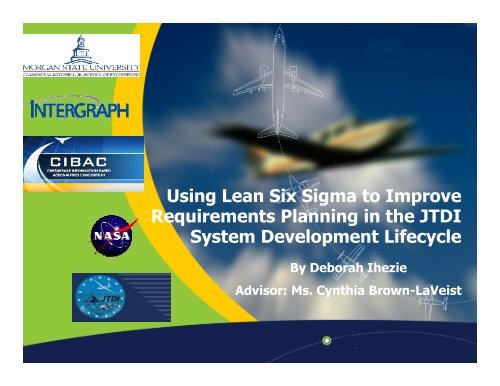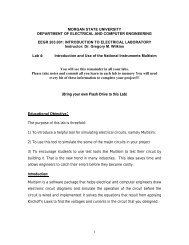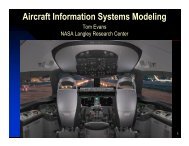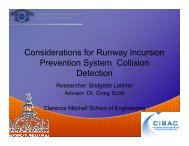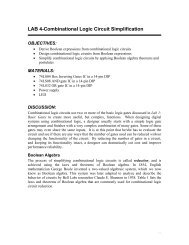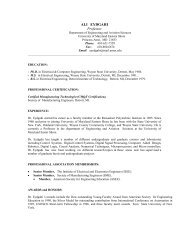Lean Six Sigma - Morgan State University
Lean Six Sigma - Morgan State University
Lean Six Sigma - Morgan State University
Create successful ePaper yourself
Turn your PDF publications into a flip-book with our unique Google optimized e-Paper software.
Using <strong>Lean</strong> <strong>Six</strong> <strong>Sigma</strong> to Improve<br />
Requirements Planning in the JTDI<br />
System Development Lifecycle<br />
By Deborah Ihezie<br />
Advisor: Ms. Cynthia Brown-LaVeist
• Project Problem <strong>State</strong>ment<br />
• Project Objective<br />
• Introduction<br />
– Why <strong>Lean</strong> <strong>Six</strong> <strong>Sigma</strong> (LSS)?<br />
– What is <strong>Lean</strong> <strong>Six</strong> <strong>Sigma</strong>?<br />
• LSS for System Development<br />
Overview
Overview Contd.<br />
• Conclusion<br />
• Future Research<br />
• Acknowledgments
Project Problem <strong>State</strong>ment<br />
• The Joint Technical Data Integration (JTDI)<br />
program is an initiative to utilize digital data<br />
for weapons systems and maintenance.<br />
• Before JTDI, the acquisition of weapons<br />
and maintenance data was a paper based<br />
process.<br />
– The process was slow and generated expensive<br />
bulky products.
Project Problem <strong>State</strong>ment<br />
• To implement JTDI, it is required to<br />
identify the most efficient way to<br />
complete the requirements analysis<br />
for the program.
Objective<br />
• The research conducted will examine how<br />
the <strong>Lean</strong> <strong>Six</strong> <strong>Sigma</strong> philosophy can be<br />
used to make the JTDI project<br />
requirements analysis phase more<br />
efficient at <strong>Morgan</strong> <strong>State</strong> <strong>University</strong>.
Introduction<br />
• Why <strong>Lean</strong> <strong>Six</strong> <strong>Sigma</strong> (LSS)?<br />
– LSS identifies and eliminates waste in all<br />
processes: manufacturing, software and<br />
service processes.<br />
– LSS is a best practice for process<br />
improvement (Public and Private Sectors).
• Why <strong>Lean</strong> <strong>Six</strong> <strong>Sigma</strong> (LSS)?<br />
Introduction<br />
– <strong>Lean</strong> and <strong>Six</strong> <strong>Sigma</strong> succeed together<br />
because:<br />
• <strong>Lean</strong> cannot bring a process under<br />
statistical control<br />
• <strong>Six</strong> <strong>Sigma</strong> alone cannot dramatically<br />
improve process speed or reduce<br />
invested capital<br />
• Both enable the reduction of the cost<br />
of complexity
<strong>Lean</strong> and <strong>Six</strong> <strong>Sigma</strong><br />
What is <strong>Lean</strong> <strong>Six</strong> <strong>Sigma</strong>?<br />
• <strong>Lean</strong> <strong>Six</strong> <strong>Sigma</strong> is the application of lean techniques to<br />
increase organizational process speed, while combining<br />
the tools and culture of <strong>Six</strong> <strong>Sigma</strong> to improve efficiencies<br />
and focus on customers’ issues.<br />
Process<br />
optimization
<strong>Lean</strong> Tools<br />
• Some popular ones include:<br />
– Kaizen<br />
– Value Stream Mapping (VSM)<br />
– Five S
<strong>Six</strong> <strong>Sigma</strong> Processes<br />
• There are two major <strong>Six</strong> <strong>Sigma</strong> processes:<br />
<strong>Six</strong> <strong>Sigma</strong> DMAIC and <strong>Six</strong> <strong>Sigma</strong> DMADV.<br />
– <strong>Six</strong> <strong>Sigma</strong> DMAIC : process that Defines,<br />
Measures, Analyzes, Improves, and<br />
Controls existing processes that fall below the<br />
<strong>Six</strong> <strong>Sigma</strong> specification.<br />
– <strong>Six</strong> <strong>Sigma</strong> DMADV: Defines, Measures,<br />
Analyzes, Designs, and Verifies new<br />
processes or products that are trying to achieve<br />
<strong>Six</strong> <strong>Sigma</strong> quality.
<strong>Lean</strong> <strong>Six</strong> <strong>Sigma</strong> Process<br />
DMAIC<br />
1. Define<br />
2. Measure<br />
3. Analyze<br />
4. Improve<br />
5. Control
System Development Lifecycle
Understanding Customer Requirements
Requirements gathering process<br />
Requirements Gathering Process<br />
Identification of SME<br />
(Subject Matter Expert)<br />
Identification of info gathering<br />
strategy<br />
Finalization of info gathering<br />
strategy<br />
Analysis/info gathering with client Documentation of info Review of info<br />
Finalization of info
SIPOC Analysis Diagram – Requirements Analysis Phase<br />
Suppliers Inputs Process Outputs Customers<br />
Project<br />
Manager<br />
Stake<br />
holders<br />
SMEs<br />
Analysis<br />
Team<br />
Project<br />
Charter<br />
Stake Holder<br />
analysis<br />
(Includes<br />
communicatio<br />
n strategy for<br />
SMEs)<br />
Requirements<br />
Document<br />
Military<br />
Maintenance<br />
Staff<br />
Input Metrics Process Metrics Output<br />
Metrics<br />
Kano Survey (Define)<br />
Run Charts (Requirements Gathering Delays<br />
vs. time) (Measure)<br />
Projected cost vs. Actual costs of the project<br />
(Microsoft Project)<br />
Automated<br />
Requirement<br />
Measurement<br />
Tool<br />
Projected vs.<br />
actual time to<br />
produce<br />
deliverable.<br />
Projected vs.<br />
Actual Cost<br />
Quality<br />
Cycle Time<br />
Cost
• Part of the Define process<br />
Project Charter<br />
• Input to Requirement Analysis process.<br />
• Generally developed by Project Manager or<br />
manager team.<br />
• <strong>State</strong>s what is expected from the team<br />
• Sets goals for project.
Stakeholder Analysis<br />
• Part of the Define process<br />
• Includes identification of<br />
stakeholders/subject matter experts (SMEs)<br />
and communication strategy.
• Part of the Define process<br />
Kano Model<br />
• Verbal or numerical data that identifies customer needs.
• Part of the Measure process<br />
Run Charts<br />
• Measure requirements gathering delays vs.<br />
time.<br />
• Once the delays have been identified. The<br />
reasons for the delays can also be identified<br />
and corrected by management.
Analyze and Improve<br />
• Brainstorming and Flow Diagrams<br />
– Document steps of a process<br />
– Set process steps to a logical flow<br />
– Uncover misconceptions and set boundaries of a<br />
process.<br />
– Improve the process by identifying and<br />
removing unnecessary steps.<br />
– Finalize a process
• Standardization<br />
Control<br />
– Make sure that improved steps in the process<br />
are performed consistently in the most effective<br />
manner.<br />
– Changes are made only when data shows that a<br />
new alternative is better.
Conclusion<br />
• The <strong>Lean</strong> <strong>Six</strong> <strong>Sigma</strong> philosophy provides a<br />
set of tools that assist in the identification<br />
and steady elimination of waste in<br />
requirements analysis.
Future Research<br />
• Continue research on <strong>Lean</strong> <strong>Six</strong> <strong>Sigma</strong> Tools.<br />
• Identify software tools for requirements<br />
documentation (Requisite Pro, DOORS, etc).<br />
• Perform modeling and simulation of the process.<br />
• Incorporate technology and knowledge from the<br />
JTDI project to demonstrate advances in aviation<br />
maintenance and aircraft availability in ways that<br />
would benefit the civil aviation community.<br />
– Perform requirements analysis and documentation of the<br />
civil aviation maintenance process.
Acknowledgements<br />
• Dr. Eugene DeLoatch<br />
• Mr. G. Haynes<br />
• Ms. Cynthia Brown-LaVeist<br />
• Dr. S. Keith Hargrove<br />
• Dr. Kemi Ladeji-Osias<br />
• Dr. Bronner<br />
• Ms. Avis Ransom<br />
• Mr. Jon Parker<br />
• CIBAC
Comparing <strong>Lean</strong> and <strong>Six</strong> <strong>Sigma</strong><br />
Comparing <strong>Lean</strong> and <strong>Six</strong> <strong>Sigma</strong><br />
<strong>Lean</strong><br />
<strong>Six</strong> <strong>Sigma</strong><br />
Goal<br />
Application<br />
Approach<br />
Create flow and eliminate<br />
waste<br />
Primarily manufacturing<br />
processes<br />
“Cookbook style"<br />
implementation based<br />
on best practice<br />
Improve process capability<br />
All business processes<br />
A problem-solving<br />
approach relying on<br />
statistics<br />
Project Selection<br />
Driven by Value Stream<br />
Map<br />
Various approaches<br />
Length of Projects 1 week to 3 months 2 to 6 months<br />
Infrastructure Little or no formal training Dedicated resources, broad<br />
based training<br />
Training Learning by doing Learning by doing
<strong>Six</strong> <strong>Sigma</strong> Processes<br />
There are two major <strong>Six</strong> <strong>Sigma</strong> processes: <strong>Six</strong> <strong>Sigma</strong> DMAIC and <strong>Six</strong><br />
<strong>Sigma</strong> DMADV.<br />
DMAIC<br />
DMADV<br />
1. Define the process improvement goals<br />
that are consistent with customer<br />
demands and enterprise strategy.<br />
2. Measure the current process and collect<br />
relevant data for future comparison.<br />
3. Analyze to verify relationship and<br />
causality of factors.<br />
4. Improve or optimize the process based<br />
upon the analysis.<br />
5. Control to ensure that any variances<br />
are corrected before they result in<br />
defects.<br />
Define the goals of the design<br />
activity that are consistent with<br />
customer demands and<br />
enterprise strategy.<br />
Measure and identify CTQs (critical<br />
to qualities), product capabilities,<br />
and risk assessments.<br />
Analyze to develop and design<br />
alternatives.<br />
Design details, optimize the design,<br />
and plan for design verification.<br />
Verify the design, implement<br />
production process and handover<br />
to process owners.
References<br />
• http://www.isixsigma.com/sixsigma/six_sigma.asp<br />
• http://en.wikipedia.org/wiki/<strong>Six</strong>_<strong>Sigma</strong><br />
• http://www.tpslean.com/leantools.htm<br />
• http://en.wikipedia.org/wiki/<strong>Six</strong>_<strong>Sigma</strong>#DMAIC<br />
• http://www.isixsigma.com/library/content/c030721a<br />
.asp<br />
• http://ww2.cis.temple.edu/barampublic/sdlc.jpg<br />
• http://www.army.mil/ArmyBTKC/focus/cpi/tools3.ht<br />
m
<strong>Lean</strong> <strong>Six</strong> <strong>Sigma</strong><br />
• What is <strong>Lean</strong> <strong>Six</strong> <strong>Sigma</strong>?<br />
– <strong>Lean</strong> <strong>Six</strong> <strong>Sigma</strong> is the application of lean techniques to<br />
increase organizational speed, while combining the tools<br />
and culture of <strong>Six</strong> <strong>Sigma</strong> to improve efficiencies and focus<br />
on customers’ issues.<br />
<strong>Lean</strong><br />
Achieving more with<br />
less resource<br />
by the continuous<br />
elimination of waste<br />
<strong>Six</strong> <strong>Sigma</strong><br />
Data-driven approach<br />
and methodology for<br />
eliminating defects<br />
in any process
<strong>Lean</strong> <strong>Six</strong> <strong>Sigma</strong> for System Development<br />
• After the initial phase of the project<br />
setup ends, the analysis phase occurs.<br />
– <strong>Lean</strong> <strong>Six</strong> <strong>Sigma</strong> can be used to ensure<br />
that the system development lifecycle is<br />
efficient.
<strong>Lean</strong> <strong>Six</strong> <strong>Sigma</strong> for Software Development<br />
• The Seven Wastes of<br />
Manufacturing<br />
• The Seven Wastes of<br />
Software Development<br />
• Inventory • Partially Done Work<br />
• Extra Processing • Extra Processes<br />
• Overproduction • Extra Features<br />
• Transportation • Task Switching<br />
• Waiting • Waiting<br />
• Motion • Motion<br />
• Defects • Defects


